
Plans for U.S.S. Sheffield, NCC 1976, by Michael C. Rupprecht and Alex Rosenzweig. These plans, published by Federation Frontiers, are the closest thing to official plans of the Miranda class to date.

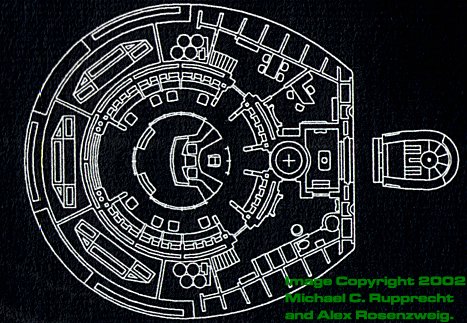 The Bridge module for the U.S.S. Sheffield is the upgraded original module to be fitted to this starship. During her major refit the module fitted to her originally in 2286 received minor modifications. The module now features all of the improvements made from the mid-2290s, including a specialised Tactical/Engineering station at the rear of the Bridge. Two turbolifts service the Bridge, as well as providing exits for the Ready Room and aft airlock.
The Bridge module for the U.S.S. Sheffield is the upgraded original module to be fitted to this starship. During her major refit the module fitted to her originally in 2286 received minor modifications. The module now features all of the improvements made from the mid-2290s, including a specialised Tactical/Engineering station at the rear of the Bridge. Two turbolifts service the Bridge, as well as providing exits for the Ready Room and aft airlock.
The Bridge module has been fully updated and upgraded with the latest technology from 2312. With the new generation Bridge modules being delivered for the Renaissance, Constellation and Excelsior class starships with a station positioned next to the captain's chair especially for the Executive Officer, these older generation of Bridge modules are being refitted.
Author's Notes:
As with the rest of U.S.S. Sheffield, this bridge is an upgraded and improved version of the the one seen on the Enterprise-A in Star Trek VI. The main differences are the additional Enterprise-B features of the Tactical/Operations station behind the Captain's chair and the large Master Situation Display behind the Tactical station, flanked by two additional Master Situation stations. The digital clocks from Star Trek VI have also been removed and the Bridge layout is identical to the Enterprise-B, including the reversed Helm and Navigation stations. In addition, I have chosen to have the dedication plaque in the style of the Enterprise-B, rather than the periodically correct Enterprise-A version both to convey a more modern ship and to have a space for the names of those people who have inspired or assisted in the creation and development of the Interim Years. This tradition continues the one started with the Enterprise-D plaque in 1986.
The choice of upgraded Enterprise-A/ -B hybrid style Bridge module is in the best tradition of the Kirk Movie Bridge modules - to portray a smaller starship than an Excelsior class. The Enterprise-A Bridge design produces the more 'cosy' feel of a light cruiser. The Bridge also gives the feel of the entire ship; the 'original, but modified' nature of the ship - and one with a 25-year history.
Stations (Clockwise from the Main Viewscreen).
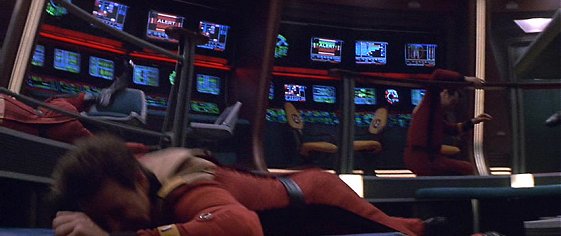
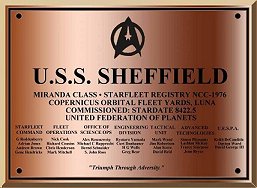 Mission Ops: 2-seat station responsible for the assignment of resources and priorities according to the guidelines specified by the Operations Officer and by operating protocols. Mission Ops ensures computer control does not unduly compromise any mission priorities, especially during unforseen situations. telemetry and tricorder data are monitored from Away Teams and transporter 'windows' are monitored.
Mission Ops: 2-seat station responsible for the assignment of resources and priorities according to the guidelines specified by the Operations Officer and by operating protocols. Mission Ops ensures computer control does not unduly compromise any mission priorities, especially during unforseen situations. telemetry and tricorder data are monitored from Away Teams and transporter 'windows' are monitored.
This is the station for monitoring mission-specific operational requirements, rather than the Operations Manager role of managing the requirements for the starship itself. This station can be manned either by a mission operations officer or by an enlisted member of the crew with a command or engineering specialisation.
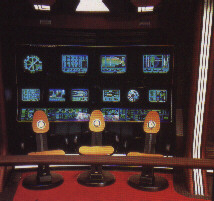 Environment: The 3-seat Environment station monitors and controls life support systems including: artificial gravity, heat exchange, food synthesis and service, water, waste management and hazardous waste management. During Alert and crisis situations, Environment monitors and allocates life support resources to maximise crew survivability. The Environmental System Officer is authorized to initiate Yellow and Red Alert conditions and is responsible for the execution of survival scenarios such as evacuation to environmental shelter areas.
Environment: The 3-seat Environment station monitors and controls life support systems including: artificial gravity, heat exchange, food synthesis and service, water, waste management and hazardous waste management. During Alert and crisis situations, Environment monitors and allocates life support resources to maximise crew survivability. The Environmental System Officer is authorized to initiate Yellow and Red Alert conditions and is responsible for the execution of survival scenarios such as evacuation to environmental shelter areas.
One of the most vital stations on the bridge. This was the station Hawkins first manned on the old Constitution class U.S.S Potemkin. This station is usually manned by an engineering division enlisted crewperson. The system - like most on the Sheffield - usually operates on a fairly automated basis, reflecting the lean-manning approach to starship operation.
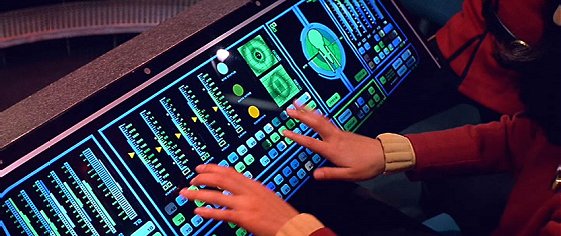 Helm: Manned by the Helm Control Officer. Responsibilities include: status of shipboard activities, supervision of power allocations, continuous revised Action Status Menus for command review, designated weapon control and shield activation (if no Tactical Officer present). Helm is also responsible for manual flight operations including: monitoring relativistic effects at impulse speeds as well as inertial dampening status. During Alert status, flight rules permit Helm to specify manoevres that are potentially dangerous to the ship or crew.
Helm: Manned by the Helm Control Officer. Responsibilities include: status of shipboard activities, supervision of power allocations, continuous revised Action Status Menus for command review, designated weapon control and shield activation (if no Tactical Officer present). Helm is also responsible for manual flight operations including: monitoring relativistic effects at impulse speeds as well as inertial dampening status. During Alert status, flight rules permit Helm to specify manoevres that are potentially dangerous to the ship or crew.
From this console, Temir Birehn liases with one of the two dolphin members of crew - Swift Fin and Eyes Sparkle - to manoevre the Sheffield in the most efficient manner. Birehn can override commands from the cetatean crew on the captain's orders. The helm console manages the power distribution for the manoevring jets, impulse power and warp drive.
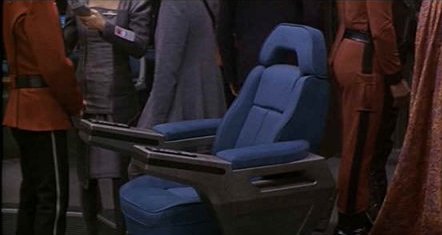 Conn: The captain's chair sits in the centre of the Bridge. From here Captain Hawkins can see most of the Bridge station displays. The controls on the arms of the chair allow the captain access to communication channels, Ship's Address System and access to the ship's library {LCARS} and main systems computer. The control can also change the ship's status to Yellow or Red Alert. New upgrades in Sheffield allow Captain Hawkins to override the basic operation of the ship, duplicating Helm and Navigation controls and operated by keyboard or vocal command.
Conn: The captain's chair sits in the centre of the Bridge. From here Captain Hawkins can see most of the Bridge station displays. The controls on the arms of the chair allow the captain access to communication channels, Ship's Address System and access to the ship's library {LCARS} and main systems computer. The control can also change the ship's status to Yellow or Red Alert. New upgrades in Sheffield allow Captain Hawkins to override the basic operation of the ship, duplicating Helm and Navigation controls and operated by keyboard or vocal command.
This is the heart of starship operations. From here, Nathaniel Hawkins, captain of the Sheffield, can quickly gather information from his departments, be advised on the meaning of the findings by his senior staff, and make informed decisions based on the data.
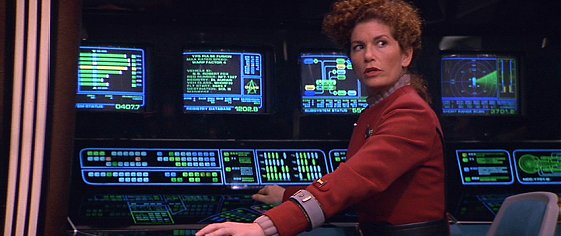 Science: This two-seat high-resolution information processing station is used to provide realtime scientific data in order to supplement Mission Ops in supporting command decision-making. All ship's sensors, both mission-specific and multi-functional, are accessible to the Science Officer. Science can also act as a command post for coordination of activities of various science laboratories and other departments, as well as for monitoring of secondary mission status. Science can reconfigure and recalibrate sensor systems at a moment's notice for specific command intelligence requirements.
Science: This two-seat high-resolution information processing station is used to provide realtime scientific data in order to supplement Mission Ops in supporting command decision-making. All ship's sensors, both mission-specific and multi-functional, are accessible to the Science Officer. Science can also act as a command post for coordination of activities of various science laboratories and other departments, as well as for monitoring of secondary mission status. Science can reconfigure and recalibrate sensor systems at a moment's notice for specific command intelligence requirements.
This is the usual station for Lieutenant Commander Judith Peers when she is not down in the social sciences department. From here she can run all of her studies as well as manage the various science departments around the starship.
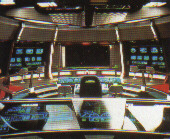 Tactical: Dedicated to starship internal security and defensive systems control. Tactical has an unobscured view of the Main Viewer due to its raised position. This allows the Tactical Officer to exchange information with the captain whilst able to see the information on the viewscreen.
Tactical: Dedicated to starship internal security and defensive systems control. Tactical has an unobscured view of the Main Viewer due to its raised position. This allows the Tactical Officer to exchange information with the captain whilst able to see the information on the viewscreen.
Tactical operates in a tier-system: benign, low-level observation of basic crew safety, second tier security during diplomatic and cultural missions and third tier counter-terrorist operations. Security teams can be controlled from Tactical via voice or keyboard input. armoury inventories, security team personnel assignments and detailed directives are all controlled by Tactical.
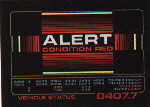
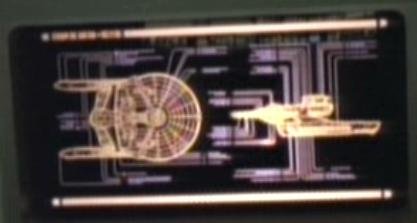 The very survival of Sheffield may rest in Tactical. In the performance of operations hazardous situations include: celestial bodies, artificial constructs and Threat vessels. A wide variety of defensive options are open to the Tactical Officer including: shields and deflector screens, phasers and photon torpedoes. Tactical coordinates with Helm, Navigation and Science in all situations involving external hazards. Other systems that may be commanded by Tactical include long- and short-range sensor arrays, sensor probes, message buoys and tractor beam devices.
The very survival of Sheffield may rest in Tactical. In the performance of operations hazardous situations include: celestial bodies, artificial constructs and Threat vessels. A wide variety of defensive options are open to the Tactical Officer including: shields and deflector screens, phasers and photon torpedoes. Tactical coordinates with Helm, Navigation and Science in all situations involving external hazards. Other systems that may be commanded by Tactical include long- and short-range sensor arrays, sensor probes, message buoys and tractor beam devices.
The tactical/operations station comes from the Enterprise-B which itself was homage to Worf's original on the Enterprise-D. It is also meant to reflect a retro-version of the Tactical station on the U.S.S. Brattain - as featured in season 4 TNG episode Night Terrors. That 1990 bridge set was the first screened to portray an aft display with Master Situation on it on the bridge, rather than Engineering, although the 1989 U.S.S. Hathaway set had a diagram of that Constellation class starship on one of the upper displays.
This Tactical station is usually manned by Lieutenant Oggta or one of his deputies, such as Ensign Price. From this console he can monitor the tactical and security situation around the ship, select appropriate measured responses and also liaise with the Security Operations division led by Lieutenant (j.g.) Arin Thera.
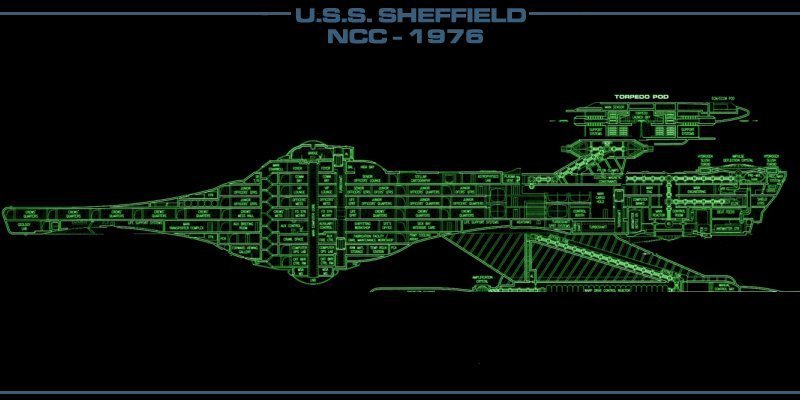
Master Situation: This is a large wall display behind the Tactical and Engineering stations, featuring a cutaway of Sheffield. This display shows the location of key systems and hardware, highlighting any elements that are currently experiencing any condition out of nominal. This display also incorporates controls to permit use of this station for troubleshooting.
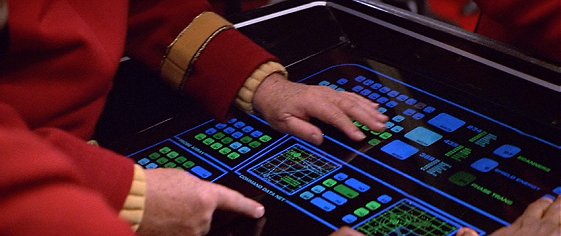 Operations: This station presents the Operations Officer with a live feed of all activities onboard the ship. This allows the Ops Officer to schedule sensor and resource useage and resolve conflicts. The Operations Officer has the authority to prioritise one request over another in accordance with the standing mission parameters and Captain's orders. This station duplicates, in a simplified form, the Chief Engineer's primary status displays from Main Engineering. These displays include Structural Integrity and Inertial Dampening systems. This station can also operate tractor beam and transporter systems, as well as all the functions of Main Engineering and the Main Computer.
Operations: This station presents the Operations Officer with a live feed of all activities onboard the ship. This allows the Ops Officer to schedule sensor and resource useage and resolve conflicts. The Operations Officer has the authority to prioritise one request over another in accordance with the standing mission parameters and Captain's orders. This station duplicates, in a simplified form, the Chief Engineer's primary status displays from Main Engineering. These displays include Structural Integrity and Inertial Dampening systems. This station can also operate tractor beam and transporter systems, as well as all the functions of Main Engineering and the Main Computer.
This station is normally manned by the Operations Officer Lieutenant Commander S'sana or one of the junior Operations Officers. On occasions when he emerges from Main Engineering, Lieutenant Sean O'Reilly may use this station, just as the Chief Engineer - played by Tim Russ - did in ST: Generations, although Propulsion Systems station is a more likely position. Perhaps Tim Russ' chief engineer was covering for the Operations Officer due there on Tuesday? As with the Enterprise-A set, there was no station labelled as 'engineering' on the Bridge. Given this station duplicated the transporter functions and many of the functions we would see Lt. Commander Data perform on the Enterprise-D, this suggests that this station has a function like Ops.
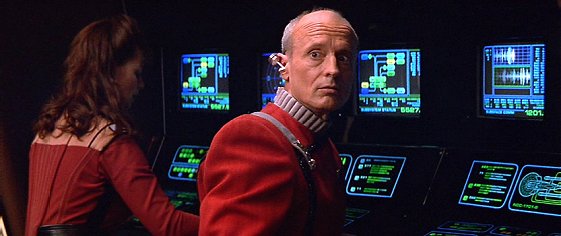 Communications: 2-seat station consisting of a class one capable subspace radio with 74 000 channel capacity receiver and sender of audio/visual transmissions. This system is equipped with a Sternbach/Okuda Language Translator, ultra high-power subspace interference filters, including coding and decoding capabilities. The system also possesses higher encryption levels for secure transmissions and a constant open channel to Starfleet Command. Communications is responsible for intraship communications, ship-to-ship communications and ship-to-ground communications, from messages from one person to another to Main Viewer communication and data transmission transmitting and receiving.
Communications: 2-seat station consisting of a class one capable subspace radio with 74 000 channel capacity receiver and sender of audio/visual transmissions. This system is equipped with a Sternbach/Okuda Language Translator, ultra high-power subspace interference filters, including coding and decoding capabilities. The system also possesses higher encryption levels for secure transmissions and a constant open channel to Starfleet Command. Communications is responsible for intraship communications, ship-to-ship communications and ship-to-ground communications, from messages from one person to another to Main Viewer communication and data transmission transmitting and receiving.
This station is manned by Lieutenant Tissiah Chyllar. Occasionally there are additional personnel either from the cryptic or intelligence departments, utilising the powerful sensor arrays of the Sheffield to detect and decrypt messages from races friendly, unknown and even hostiles.
 Navigation: This station is responsible for the navigation of Sheffield at Impulse and Warp speeds. Navigation displays readings from navigation and tactical sensors, overlaying them on current positional and course projections. Navigation has the option of accessing data feeds from secondary navigation and science sensors, for verification of primary sensor data. Such cross-checks are performed at change-of-shift or activation of Alert status. Flight information input can be done in numerous ways: Destination planet, star system or sector, spacecraft intercept and reletive bearing, Absolute Bearing or Galactic coordinates.
Navigation: This station is responsible for the navigation of Sheffield at Impulse and Warp speeds. Navigation displays readings from navigation and tactical sensors, overlaying them on current positional and course projections. Navigation has the option of accessing data feeds from secondary navigation and science sensors, for verification of primary sensor data. Such cross-checks are performed at change-of-shift or activation of Alert status. Flight information input can be done in numerous ways: Destination planet, star system or sector, spacecraft intercept and reletive bearing, Absolute Bearing or Galactic coordinates.
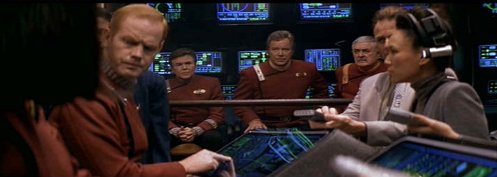 Propulsion Systems: 3-seat station that monitors the Reaction Control Thrusters, Impulse and Warp Drive systems, deuterium and antimatter fuel usage and reserves involved in making Sheffield move. In full enable mode this console can actively override and control all propulsion systems.
Propulsion Systems: 3-seat station that monitors the Reaction Control Thrusters, Impulse and Warp Drive systems, deuterium and antimatter fuel usage and reserves involved in making Sheffield move. In full enable mode this console can actively override and control all propulsion systems.
This is another station normally manned by an engineering enlisted person. Normally this post requires only monitoring but can be used for overriding in an emergency. The Chief Engineering Officer may use this station to duplicate functions from Main Engineering should he wish.
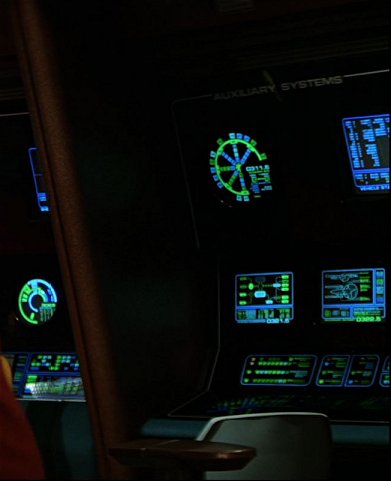
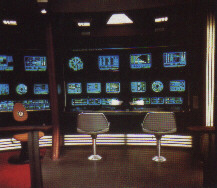 Auxiliary Systems: 2-seat station that provides graphic displays of all command systems, indicating the operational condition of each, schedules of maintainance and/or replacement. It automatically transfers function to auxiliary back-up units in case of general or selective system failure.
Auxiliary Systems: 2-seat station that provides graphic displays of all command systems, indicating the operational condition of each, schedules of maintainance and/or replacement. It automatically transfers function to auxiliary back-up units in case of general or selective system failure.
Many of the ship's systems are automatic [see notes on Ship's Computer] and run independantly of external operation. Sheffield's bridge stations usually deal with immediate operations concerning the ship. The remainding, more mundane and repetative functions are controlled by the Main Computer. Should the Bridge crew wish to perform or override any ships function, they may do so with very few vocal or keyboard inputs.
Author's notes:
As mentioned above, the Bridge of the Sheffield is the brain of the starship, and the set that gets the most usage in the television series and movies. For the Interim Years, I wanted to have a Bridge that looked both familiar and yet also conveyed a sense of progression since the time of Star Trek VI.
The Enterprise-B Bridge set was the most advanced one shown for the William Shatner movie series and was the instant choice for the job. As a Miranda class starship is not as big as Excelsior, a smaller Bridge was necessary. Whereas the Reliant had a single turbolift, this more modern variant has two.
The Sheffield Bridge is much more cramped in feel than the Enterprise, with the addition of the tactical station at the aft. This is more than compensated for by the much more functional feel and practicality of your tactical officer looking forwards. The turbolifts retain the red colour that they had on the Enterprise-A, yet the seating and captain's chair are all from the Enterprise-B.
The LCARS style of the Bridge is the same as what was seen from the era of the USS Bozeman (2278-ish) onwards, although this does not discount the graphics being from an earlier unseen era. Mike Okuda's unique style was first seen on the USS Saratoga in Star Trek IV, with the Bozeman appearance being a re-conned appearance from TNG 'Cause and Effect' episode.
As coached by Mike Okuda to Jacqueline Kim, who played Demora Sulu in Star Trek Generations, this style of LCARS buttons can be operated by either pressing the buttons, wobbling them, pressing a cluster with multiple fingers or palm of the hand or by swiping them in a stroke - as the actress later did in the movie itself.
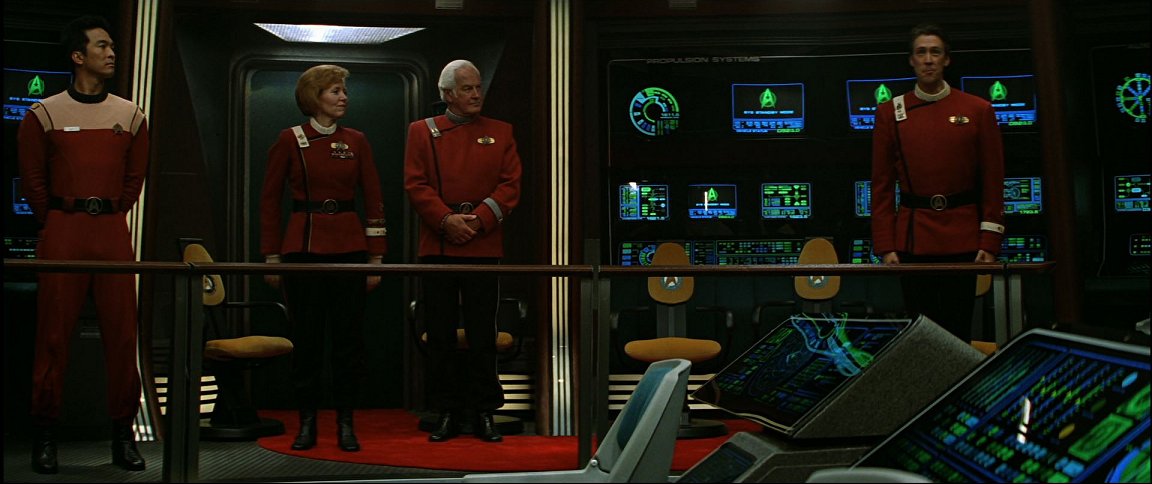
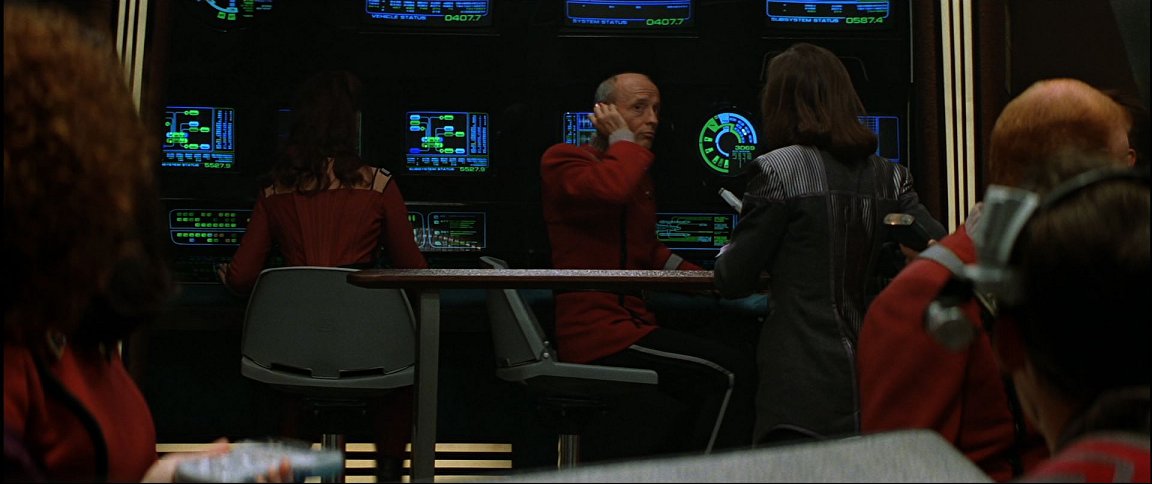
Diagram of the Main Bridge:
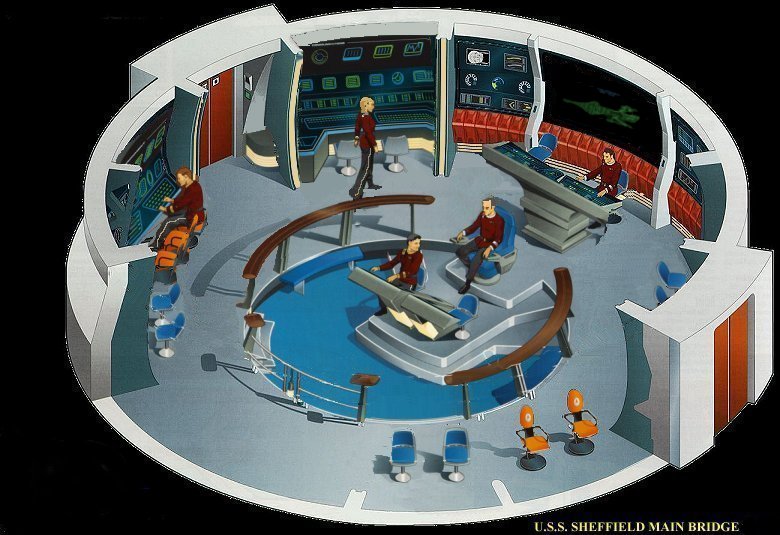
"The above artwork is © Star Trek Fact Files. All rights reserved"







 The Bridge module for the U.S.S. Sheffield is the upgraded original module to be fitted to this starship. During her major refit the module fitted to her originally in 2286 received minor modifications. The module now features all of the improvements made from the mid-2290s, including a specialised Tactical/Engineering station at the rear of the Bridge. Two turbolifts service the Bridge, as well as providing exits for the Ready Room and aft airlock.
The Bridge module for the U.S.S. Sheffield is the upgraded original module to be fitted to this starship. During her major refit the module fitted to her originally in 2286 received minor modifications. The module now features all of the improvements made from the mid-2290s, including a specialised Tactical/Engineering station at the rear of the Bridge. Two turbolifts service the Bridge, as well as providing exits for the Ready Room and aft airlock.
 Mission Ops: 2-seat station responsible for the assignment of resources and priorities according to the guidelines specified by the Operations Officer and by operating protocols. Mission Ops ensures computer control does not unduly compromise any mission priorities, especially during unforseen situations. telemetry and tricorder data are monitored from Away Teams and transporter 'windows' are monitored.
Mission Ops: 2-seat station responsible for the assignment of resources and priorities according to the guidelines specified by the Operations Officer and by operating protocols. Mission Ops ensures computer control does not unduly compromise any mission priorities, especially during unforseen situations. telemetry and tricorder data are monitored from Away Teams and transporter 'windows' are monitored. Environment: The 3-seat Environment station monitors and controls life support systems including: artificial gravity, heat exchange, food synthesis and service, water, waste management and hazardous waste management. During Alert and crisis situations, Environment monitors and allocates life support resources to maximise crew survivability. The Environmental System Officer is authorized to initiate Yellow and Red Alert conditions and is responsible for the execution of survival scenarios such as evacuation to environmental shelter areas.
Environment: The 3-seat Environment station monitors and controls life support systems including: artificial gravity, heat exchange, food synthesis and service, water, waste management and hazardous waste management. During Alert and crisis situations, Environment monitors and allocates life support resources to maximise crew survivability. The Environmental System Officer is authorized to initiate Yellow and Red Alert conditions and is responsible for the execution of survival scenarios such as evacuation to environmental shelter areas. Helm: Manned by the Helm Control Officer. Responsibilities include: status of shipboard activities, supervision of power allocations, continuous revised Action Status Menus for command review, designated weapon control and shield activation (if no Tactical Officer present). Helm is also responsible for manual flight operations including: monitoring relativistic effects at impulse speeds as well as inertial dampening status. During Alert status, flight rules permit Helm to specify manoevres that are potentially dangerous to the ship or crew.
Helm: Manned by the Helm Control Officer. Responsibilities include: status of shipboard activities, supervision of power allocations, continuous revised Action Status Menus for command review, designated weapon control and shield activation (if no Tactical Officer present). Helm is also responsible for manual flight operations including: monitoring relativistic effects at impulse speeds as well as inertial dampening status. During Alert status, flight rules permit Helm to specify manoevres that are potentially dangerous to the ship or crew. Conn: The captain's chair sits in the centre of the Bridge. From here Captain Hawkins can see most of the Bridge station displays. The controls on the arms of the chair allow the captain access to communication channels, Ship's Address System and access to the ship's library {LCARS} and main systems computer. The control can also change the ship's status to Yellow or Red Alert. New upgrades in Sheffield allow Captain Hawkins to override the basic operation of the ship, duplicating Helm and Navigation controls and operated by keyboard or vocal command.
Conn: The captain's chair sits in the centre of the Bridge. From here Captain Hawkins can see most of the Bridge station displays. The controls on the arms of the chair allow the captain access to communication channels, Ship's Address System and access to the ship's library {LCARS} and main systems computer. The control can also change the ship's status to Yellow or Red Alert. New upgrades in Sheffield allow Captain Hawkins to override the basic operation of the ship, duplicating Helm and Navigation controls and operated by keyboard or vocal command. Science: This two-seat high-resolution information processing station is used to provide realtime scientific data in order to supplement Mission Ops in supporting command decision-making. All ship's sensors, both mission-specific and multi-functional, are accessible to the Science Officer. Science can also act as a command post for coordination of activities of various science laboratories and other departments, as well as for monitoring of secondary mission status. Science can reconfigure and recalibrate sensor systems at a moment's notice for specific command intelligence requirements.
Science: This two-seat high-resolution information processing station is used to provide realtime scientific data in order to supplement Mission Ops in supporting command decision-making. All ship's sensors, both mission-specific and multi-functional, are accessible to the Science Officer. Science can also act as a command post for coordination of activities of various science laboratories and other departments, as well as for monitoring of secondary mission status. Science can reconfigure and recalibrate sensor systems at a moment's notice for specific command intelligence requirements. Tactical: Dedicated to starship internal security and defensive systems control. Tactical has an unobscured view of the Main Viewer due to its raised position. This allows the Tactical Officer to exchange information with the captain whilst able to see the information on the viewscreen.
Tactical: Dedicated to starship internal security and defensive systems control. Tactical has an unobscured view of the Main Viewer due to its raised position. This allows the Tactical Officer to exchange information with the captain whilst able to see the information on the viewscreen.
 The very survival of Sheffield may rest in Tactical. In the performance of operations hazardous situations include: celestial bodies, artificial constructs and Threat vessels. A wide variety of defensive options are open to the Tactical Officer including: shields and deflector screens, phasers and photon torpedoes. Tactical coordinates with Helm, Navigation and Science in all situations involving external hazards. Other systems that may be commanded by Tactical include long- and short-range sensor arrays, sensor probes, message buoys and tractor beam devices.
The very survival of Sheffield may rest in Tactical. In the performance of operations hazardous situations include: celestial bodies, artificial constructs and Threat vessels. A wide variety of defensive options are open to the Tactical Officer including: shields and deflector screens, phasers and photon torpedoes. Tactical coordinates with Helm, Navigation and Science in all situations involving external hazards. Other systems that may be commanded by Tactical include long- and short-range sensor arrays, sensor probes, message buoys and tractor beam devices.
 Operations: This station presents the Operations Officer with a live feed of all activities onboard the ship. This allows the Ops Officer to schedule sensor and resource useage and resolve conflicts. The Operations Officer has the authority to prioritise one request over another in accordance with the standing mission parameters and Captain's orders. This station duplicates, in a simplified form, the Chief Engineer's primary status displays from Main Engineering. These displays include Structural Integrity and Inertial Dampening systems. This station can also operate tractor beam and transporter systems, as well as all the functions of Main Engineering and the Main Computer.
Operations: This station presents the Operations Officer with a live feed of all activities onboard the ship. This allows the Ops Officer to schedule sensor and resource useage and resolve conflicts. The Operations Officer has the authority to prioritise one request over another in accordance with the standing mission parameters and Captain's orders. This station duplicates, in a simplified form, the Chief Engineer's primary status displays from Main Engineering. These displays include Structural Integrity and Inertial Dampening systems. This station can also operate tractor beam and transporter systems, as well as all the functions of Main Engineering and the Main Computer. Communications: 2-seat station consisting of a class one capable subspace radio with 74 000 channel capacity receiver and sender of audio/visual transmissions. This system is equipped with a Sternbach/Okuda Language Translator, ultra high-power subspace interference filters, including coding and decoding capabilities. The system also possesses higher encryption levels for secure transmissions and a constant open channel to Starfleet Command. Communications is responsible for intraship communications, ship-to-ship communications and ship-to-ground communications, from messages from one person to another to Main Viewer communication and data transmission transmitting and receiving.
Communications: 2-seat station consisting of a class one capable subspace radio with 74 000 channel capacity receiver and sender of audio/visual transmissions. This system is equipped with a Sternbach/Okuda Language Translator, ultra high-power subspace interference filters, including coding and decoding capabilities. The system also possesses higher encryption levels for secure transmissions and a constant open channel to Starfleet Command. Communications is responsible for intraship communications, ship-to-ship communications and ship-to-ground communications, from messages from one person to another to Main Viewer communication and data transmission transmitting and receiving. Navigation: This station is responsible for the navigation of Sheffield at Impulse and Warp speeds. Navigation displays readings from navigation and tactical sensors, overlaying them on current positional and course projections. Navigation has the option of accessing data feeds from secondary navigation and science sensors, for verification of primary sensor data. Such cross-checks are performed at change-of-shift or activation of Alert status. Flight information input can be done in numerous ways: Destination planet, star system or sector, spacecraft intercept and reletive bearing, Absolute Bearing or Galactic coordinates.
Navigation: This station is responsible for the navigation of Sheffield at Impulse and Warp speeds. Navigation displays readings from navigation and tactical sensors, overlaying them on current positional and course projections. Navigation has the option of accessing data feeds from secondary navigation and science sensors, for verification of primary sensor data. Such cross-checks are performed at change-of-shift or activation of Alert status. Flight information input can be done in numerous ways: Destination planet, star system or sector, spacecraft intercept and reletive bearing, Absolute Bearing or Galactic coordinates. Propulsion Systems: 3-seat station that monitors the Reaction Control Thrusters, Impulse and Warp Drive systems, deuterium and antimatter fuel usage and reserves involved in making Sheffield move. In full enable mode this console can actively override and control all propulsion systems.
Propulsion Systems: 3-seat station that monitors the Reaction Control Thrusters, Impulse and Warp Drive systems, deuterium and antimatter fuel usage and reserves involved in making Sheffield move. In full enable mode this console can actively override and control all propulsion systems.
 Auxiliary Systems: 2-seat station that provides graphic displays of all command systems, indicating the operational condition of each, schedules of maintainance and/or replacement. It automatically transfers function to auxiliary back-up units in case of general or selective system failure.
Auxiliary Systems: 2-seat station that provides graphic displays of all command systems, indicating the operational condition of each, schedules of maintainance and/or replacement. It automatically transfers function to auxiliary back-up units in case of general or selective system failure.





